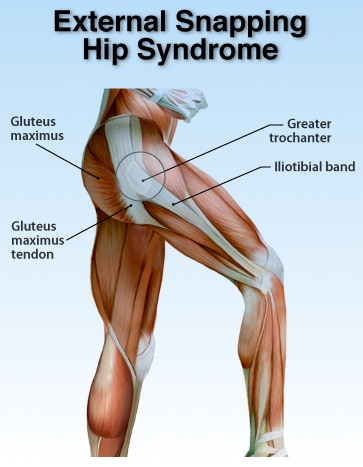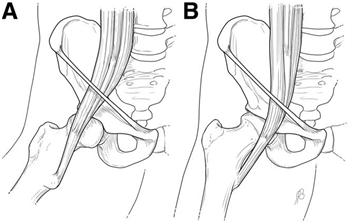Snapping Hip Syndrome is characterized by an audible and sometimes visible “snapping” or “cracking” sensation of the hip that generally occurs when the leg is moved in a certain way.
The most common reason for snapping hip is movement of the fascia of the outside of the leg (the fascia lata/iliotibial band complex, which extends from the side of the pelvis to the outside of the knee) over the bony prominence on the outside of the hip (known as the greater trochanter). This most frequently occurs in young athletic females who perform activities that involve repetitive flexion and extension of the hip (eg dancing/cycling). The snapping can usually be demonstrated by the afflicted individual and can usually be seen on the outside of the upper thigh. The snapping sensation is usually not painful but if the trochanteric bursa becomes inflamed as a result of friction between the fascia and the bone of the trochanter, then pain can result (see Trochanteric Pain Syndrome).

Most cases of snapping hip require no specific treatment other than reassurance that the condition is not serious and will not lead to hip joint disease in the future. If the snapping is annoying but not painful, modification of exacerbating activities combined with a program of physiotherapy for fascial stretches, gluteal strengthening and instruction regarding the use of a foam roller or similar device can be helpful. If pain is a significant issue then this can be combatted by use of analgesics, anti-inflammatories and sometimes an injection of local anaesthetic and cortisone into the trochanteric bursa.
Surgery is rarely required but is occasionally indicated in resistant painful cases. It is important to have plain xrays and probably an MRI scan to rule out local bony or soft tissue pathology in the region of the trochanter. Surgery involves release or lengthening of the fascia lata/iliotibial band which is usually very tight together with removal of any bony projections from the greater trochanter.
The second most common cause of snapping hip syndrome is a condition called coxa saltans interna. This condition is caused by the main hip flexor tendon (iliopsoas tendon) contacting the front of the socket of the hip or a bony part of the pelvis called the iliopectineal eminence. This creates snapping felt at the front of the hip or deep in the groin (as opposed to the outside of the hip), again generally with hip flexion or sometimes rotation. This snapping can be painless or painful. Other causes of snapping at the front of the hip include part of the quadriceps (the rectus femoris tendon) contacting the ball (femoral head) of the hip joint and tears of the cartilage (labrum) of the hip joint. A dynamic ultrasound investigation may enable the “snapping” structure to be identified. Treatment of snapping psoas tendon follows the same basic principles as for snapping fascia lata/iliotibial band with non-operative treatment being the mainstay and surgical release reserved for rare cases unresponsive to physical therapies.
Figure 2. Movement of the ilio-psoas tendon creating “snapping” at the front of the hip.

